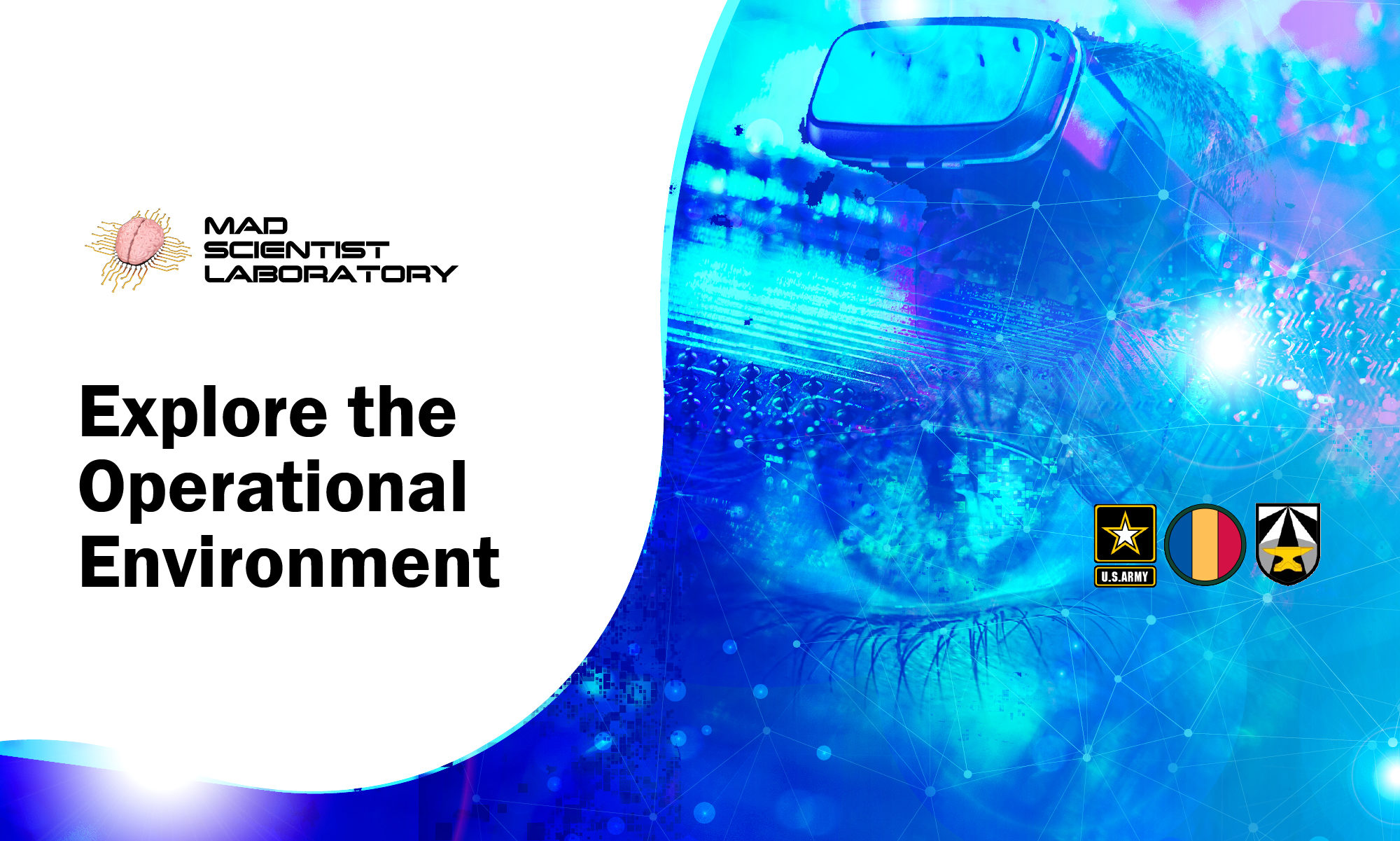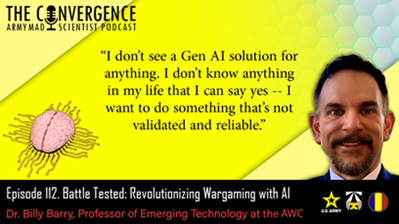“I don’t see a Gen AI solution for anything. I don’t know anything in my life that I can say yes — I want to do something that’s not validated and reliable.”
Today’s The Convergence podcast welcomes back proclaimed Mad Scientist Dr. Billy Barry, Professor of Emerging Technology at the U.S. Army War College, to discuss his latest innovation — an Artificial Intelligence (AI)-enabled digital war game. We tested this capability with two of the TRADOC G-2’s most experienced wargamers to get their thoughts on how it performed and its potential to democratize access to wargaming and potentially revolutionize Army training and strategic planning — Read on!]
[If the podcast dashboard is not rendering correctly for you, please click here to listen to the podcast.]
 Dr. Billy Barry is a Professor of Emerging Technology and Principal Strategist of the Artificial Intelligence/Intelligence Augmentation (AI/IA) Program for the Center for Strategic Leadership at the United States Army War College. Before working at the Army War College, Dr. Barry was a visiting professor of Philosophy and Just War Theory at the United States Military Academy at West Point. A pioneer in Human-AI/Intelligent Augmentation (IA) teams, he is the first to introduce AI-powered IA androids, robots, digital virtual beings, and strategic advisors as teaching and learning partners in civilian university and Professional Military Education classrooms. A sought-after TEDx and international keynote speaker, Dr. Barry’s influence extends to Fortune 500 companies and global leadership symposiums and conferences. His current research interest centers on non-invasive brain-computer interfaces, driving the conversation on ethical technology interactions. His contributions to academia and industry establish him as a leading authority on the future of human relationships with emerging technology.
Dr. Billy Barry is a Professor of Emerging Technology and Principal Strategist of the Artificial Intelligence/Intelligence Augmentation (AI/IA) Program for the Center for Strategic Leadership at the United States Army War College. Before working at the Army War College, Dr. Barry was a visiting professor of Philosophy and Just War Theory at the United States Military Academy at West Point. A pioneer in Human-AI/Intelligent Augmentation (IA) teams, he is the first to introduce AI-powered IA androids, robots, digital virtual beings, and strategic advisors as teaching and learning partners in civilian university and Professional Military Education classrooms. A sought-after TEDx and international keynote speaker, Dr. Barry’s influence extends to Fortune 500 companies and global leadership symposiums and conferences. His current research interest centers on non-invasive brain-computer interfaces, driving the conversation on ethical technology interactions. His contributions to academia and industry establish him as a leading authority on the future of human relationships with emerging technology.
In our latest episode of The Convergence podcast, Dr. Billy Barry visited TRADOC to demonstrate his custom-made digital war game using his new Deterministic Constraint Processing (DCP) idea. Seasoned TRADOC G-2 wargamers Kate Kilgore and Dorsel “Flip” Boyer II tested several scenarios of Dr. Barry’s wargame and provide their insightful feedback regarding how this tool could be used by the Army. The following bullet points highlight the key insights from this conversation.
-
-
- Dr. Barry created a custom-made digital war game using DCP on top of the ChatGPT framework. Using DCP as a methodological framework to transform probabilistic Generative AI (Gen AI) systems into
 deterministic, rule-bound models, Dr. Barry’s Hybrid Deterministic Generative AI (HDGAI) system rigorously enforces semantic validity, epistemic integrity, and ethical logic through structured token selection processes, preventing semantic drift and computational inaccuracies typical in traditional Gen AI. HDGAI is designed to be auditable, transparent, and free from “hallucinations” or unpredictable outputs, making it a more reliable tool for exploring the viability of courses of action and strategic decision-making.
deterministic, rule-bound models, Dr. Barry’s Hybrid Deterministic Generative AI (HDGAI) system rigorously enforces semantic validity, epistemic integrity, and ethical logic through structured token selection processes, preventing semantic drift and computational inaccuracies typical in traditional Gen AI. HDGAI is designed to be auditable, transparent, and free from “hallucinations” or unpredictable outputs, making it a more reliable tool for exploring the viability of courses of action and strategic decision-making.
- Dr. Barry created a custom-made digital war game using DCP on top of the ChatGPT framework. Using DCP as a methodological framework to transform probabilistic Generative AI (Gen AI) systems into
-
-
-
- Digital wargame scenarios using the HDGAI system — e.g., FLASHPOINT 2042: Taiwan Strait and ASCENDANCY 2050: The AI Uprising — significantly reduce the cost and logistical barriers associated with traditional war gaming — anyone
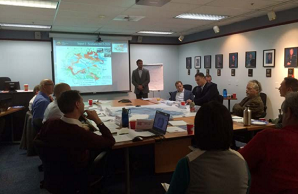 with a computer or mobile device can access and play through these games. This accessibility democratizes wargaming and allows for wider participation, including the tool’s potential use in education and training.
with a computer or mobile device can access and play through these games. This accessibility democratizes wargaming and allows for wider participation, including the tool’s potential use in education and training.
- Digital wargame scenarios using the HDGAI system — e.g., FLASHPOINT 2042: Taiwan Strait and ASCENDANCY 2050: The AI Uprising — significantly reduce the cost and logistical barriers associated with traditional war gaming — anyone
-
-
-
- When tested by experienced wargamers, the HDGAI system’s intuitive design fostered a faster learning curve and enhanced player experience.
 The ability to directly ask the system a clarifying question during gameplay – or modify the rules and structure – and receive clear explanations of outcomes enhanced players’ understanding and strategic thinking.
The ability to directly ask the system a clarifying question during gameplay – or modify the rules and structure – and receive clear explanations of outcomes enhanced players’ understanding and strategic thinking.
- When tested by experienced wargamers, the HDGAI system’s intuitive design fostered a faster learning curve and enhanced player experience.
-
-
-
-
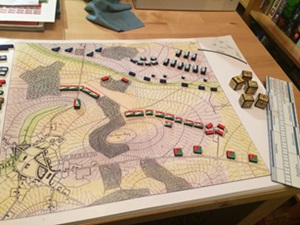
A reconstruction of a Prussian military wargame (Kriegsspiel), based on a ruleset developed by Georg Heinrich Rudolf Johann von Reiswitz in 1824 / Source: Wikimedia Commons via CC BY-SA 4.0 The HDGAI system’s transparency allowed for the identification of subtle differences and novel insights into strategic thinking. Analyzing gameplay revealed discrepancies between historical perspectives and strategic goals, highlighting nuances often missed in traditional war games.
-
-
-
-
- While designed for wargaming, the HDGAI system’s principles of
 transparency, auditability, and reliability hold promise for other fields beyond a military context, such as intelligence analysis, threat assessment, legal fields, and education.
transparency, auditability, and reliability hold promise for other fields beyond a military context, such as intelligence analysis, threat assessment, legal fields, and education.
- While designed for wargaming, the HDGAI system’s principles of
-
-
-
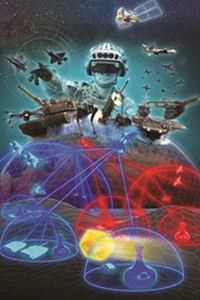 Integrating an HDGAI approach to wargaming, with its simplicity, accuracy, and trainability, could help revolutionize Army training and strategic planning. Democratizing access to sophisticated wargaming with a solid database of historical data for everyone — not just expert wargamers who have mastered arcane rules — could improve Soldiers’ military decision-making skills, provide increased opportunities for critical thinking and collaboration, accelerate learning across all ranks, and ultimately result in more agile, better informed decision making in a rapidly evolving and increasingly complex Operational Environment.
Integrating an HDGAI approach to wargaming, with its simplicity, accuracy, and trainability, could help revolutionize Army training and strategic planning. Democratizing access to sophisticated wargaming with a solid database of historical data for everyone — not just expert wargamers who have mastered arcane rules — could improve Soldiers’ military decision-making skills, provide increased opportunities for critical thinking and collaboration, accelerate learning across all ranks, and ultimately result in more agile, better informed decision making in a rapidly evolving and increasingly complex Operational Environment.
-
-
-
- Dr. Barry is currently coordinating with both the U.S. Army TRADOC
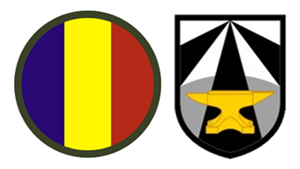 and Army Futures Command (AFC) to bring the power of his HDGAI system to these commands’ respective mission sets.
and Army Futures Command (AFC) to bring the power of his HDGAI system to these commands’ respective mission sets.
- Dr. Barry is currently coordinating with both the U.S. Army TRADOC
-

Stay tuned to the Mad Scientist Laboratory for our next episode of The Convergence on 10 April 2025.
If you enjoyed this post, review the TRADOC Pamphlet 525-92, The Operational Environment 2024-2034: Large-Scale Combat Operations
Explore the TRADOC G-2‘s Operational Environment Enterprise web page, brimming with authoritative information on the Operational Environment and how our adversaries fight, including:
Our China Landing Zone, full of information regarding our pacing challenge, including ATP 7-100.3, Chinese Tactics, BiteSize China weekly topics, People’s Liberation Army Ground Forces Quick Reference Guide, and our thirty-plus snapshots captured to date addressing what China is learning about the Operational Environment from Russia’s war against Ukraine (note that a DoD Common Access Card [CAC] is required to access this last link).
Our Russia Landing Zone, including the BiteSize Russia weekly topics. If you have a CAC, you’ll be especially interested in reviewing our weekly RUS-UKR Conflict Running Estimates and associated Narratives, capturing what we learned about the contemporary Russian way of war in Ukraine over the past two years and the ramifications for U.S. Army modernization across DOTMLPF-P.
Our Iran Landing Zone, including the latest Iran OE Watch articles, as well as the Iran Quick Reference Guide and the Iran Passive Defense Manual (both require a CAC to access).
Our Running Estimates SharePoint site (also requires a CAC to access) — documenting what we’re learning about the evolving OE. Contains our monthly OE Running Estimates, associated Narratives, and the 2QFY24, 3QFY24, 4QFY24, and 1QFY25 OE Assessment TRADOC Intelligence Posts (TIPs).
Then check out the following related Mad Scientist Laboratory content exploring wargaming…
Report from Game On! Wargaming & The Operational Environment Conference, 06-07 November 2024
Seven Reflections of a “Red Commander” — Lessons Learned Playing the Adversary in DoD Wargames, by Ian Sullivan
Hybrid Intelligence: Sustaining Adversary Overmatch and associated podcast, with Dr. Billy Barry and LTC Blair Wilcox
“Best of” Calling All Wargamers Insights (Parts 1 and 2)
Whipping Wargaming into NATO SHAPE and associated podcast, with COL Arnel David
Wargaming: A Company-Grade Perspective, by CPT Spencer D. H. Bates
Taking the Golf Out of Gaming and associated podcast, with Sebastian Bae
Civilian Harm Mitigation and Response (CHMR) Considerations in Wargaming LSCO, Achieving Victory & Ensuring Civilian Safety in Conflict Zones, and associated podcast with Andrew Olson
Brian Train on Wargaming Irregular and Urban Combat
Live from D.C., it’s Fight Night (Parts One and Two) and associated podcasts (Parts One and Two)
Would You Like to Play a Game? Wargaming as a Learning Experience and Key Assumptions Check and “No Option is Excluded” — Using Wargaming to Envision a Chinese Assault on Taiwan, by Ian Sullivan
Using Wargames to Reconceptualize Military Power, by proclaimed Mad Scientist Caroline Duckworth
Gaming the System: How Wargames Shape our Future and associated podcast, with guest panelists Ian Sullivan, Mitchell Land, LTC Peter Soendergaard, Jennifer McArdle, Becca Wasser, Dr. Stacie Pettyjohn, Sebastian Bae, Dan Mahoney, and Jeff Hodges
The Storm After the Flood virtual wargame scenario, video, notes, and Lessons Learned presentation and video, presented by proclaimed Mad Scientists Dr. Gary Ackerman and Doug Clifford, The Center for Advanced Red Teaming, University at Albany, SUNY
Gamers Building the Future Force and associated podcast
… and the transformative power of AI — spanning the gamut of potential applications:
Artificial Intelligence (AI) Trends
Takeaways Learned about the Future of the AI Battlefield and associated information paper
Artificial Intelligence: An Emerging Game-changer
Unlocking TRADOC’s Potential with GenAI: Opportunities and Challenges and Generative AI: The New Ammunition in the Data Arms Race and associated podcast, with Ben Van Roo
Artificial Intelligence: Shaping the Future of Biological-Chemical Warfare, by Jared Kite
Training Transformed: AI and the Future Soldier, by proclaimed Mad Scientist SGM Kyle J. Kramer
The AI Study Buddy at the Army War College (Part 1) and associated podcast, with LtCol Joe Buffamante, USMC
The AI Study Buddy at the Army War College (Part 2) and associated podcast, with Dr. Billy Barry, USAWC
Hybrid Intelligence: Sustaining Adversary Overmatch and associated podcast, with proclaimed Mad Scientist Dr. Billy Barry and LTC Blair Wilcox
Rise of Artificial Intelligence: Implications to the Fielded Force, by John W. Mabes III
Integrating Artificial Intelligence into Military Operations, by Dr. James Mancillas
“Own the Night” and the associated Modern War Institute podcast, with proclaimed Mad Scientist Bob Work
Bringing AI to the Joint Force and associated podcast, with Jacqueline Tame, Alka Patel, and Dr. Jane Pinelis
Thoughts on AI and Ethics… from the Chaplain Corps
Gen Z is Likely to Build Trusting Relationships with AI, by COL Derek Baird
Hey, ChatGPT, Help Me Win this Contract! and associated podcast, with LTC Robert Solano
Chatty Cathy, Open the Pod Bay Doors: An Interview with ChatGPT and associated podcast
The Future of Learning: Personalized, Continuous, and Accelerated
The Guy Behind the Guy: AI as the Indispensable Marshal, by Brady Moore and Chris Sauceda
AI Enhancing EI in War, by MAJ Vincent Dueñas
The Human Targeting Solution: An AI Story, by CW3 Jesse R. Crifasi
An Appropriate Level of Trust…
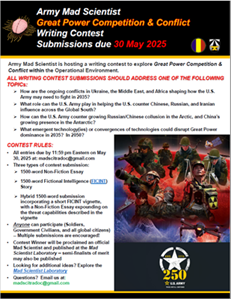 >>>>Reminder: Army Mad Scientist wants to crowdsource your thoughts on Great Power Competition & Conflict — check out the flyer describing our latest writing contest.
>>>>Reminder: Army Mad Scientist wants to crowdsource your thoughts on Great Power Competition & Conflict — check out the flyer describing our latest writing contest.
All entries must address one of the following writing prompts:
How are the ongoing conflicts in Ukraine, the Middle East, and Africa shaping how the U.S. Army may need to fight in 2035?
What role can the U.S. Army play in helping the U.S. counter Chinese, Russian, and Iranian influence across the Global South?
How can the U.S. Army counter growing Russian/Chinese collusion in the Arctic, and China’s growing presence in the Antarctic?
What emergent technology(ies) or convergences of technologies could disrupt Great Power dominance in 2035? In 2050?
We are accepting three types of submissions:
-
-
- 1500-word Non-Fiction Essay
-
-
-
- 1500-word Fictional Intelligence (FICINT) Story
-
-
-
- Hybrid 1500-word submission incorporating a short FICINT vignette, with a Non-Fiction Essay expounding on the threat capabilities described in the vignette
-
Anyone can participate (Soldiers, Government Civilians, and all global citizens) — Multiple submissions are encouraged!
All entries are due NLT 11:59 pm Eastern on May 30 , 2025 at: madscitradoc@gmail.com
Click here for additional information on this contest — we look forward to your participation!
>>>>Announcement 1: The Army Civilian Journal’s Call for Papers on Advancing Professional Knowledge, Capabilities, and Leadership of the Army Civilian Corps — Check out the associated flyer for more information (S: 01APR25 for the inaugural issue of this new journal; but note that they are also accepting later submissions for subsequent editions).
>>>>Announcement 2: The Institute for National Strategic Studies (INSS), in partnership with the Joint Staff J5’s Office of Strategic Stability and the National Defense University Foundation, invite you to its Disruptive Weapons and Future Warfare hybrid conference on 29MAY25 — Check out the associated flyer for more information (S: Register to participate NLT 02APR25).
>>>>Announcement 3: The Assistant Secretary of the Army for Acquisition, Logistics and Technology (ASA(ALT)) is partnering with U.S. Army Pacific (USARPAC) and the Army’s Catalyst Pathfinder Program to deliver the xTechPacific 2025 competition — for more information about this small business opportunity, click here. If you’d like to participate as judge for this competition, register here.
Disclaimer: The views expressed in this blog post do not necessarily reflect those of the U.S. Department of Defense, Department of the Army, Army Futures Command (AFC), or Training and Doctrine Command (TRADOC).
